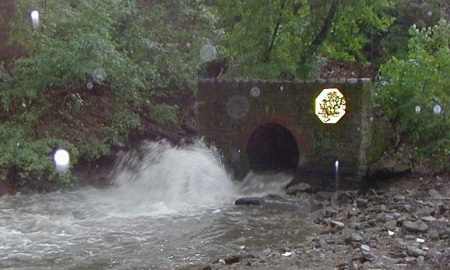With the Philadelphia Water Department proposing a rate change for 2013, we’re running a series of informational posts to explain how water rates are set, the terminology behind the rate setting process, and the investments PWD is making in our city’s infrastructure, health and environment.

A combined sewer overflow
As we wrote in our post explaining what it means to be a “cost of service” utility, PWD doesn’t operate to make a profit. We simply need to set rates so that we cover our annual costs and long-term debt obligations without ever needing a bailout from the City of Philadelphia. So our rates change for the most part as our costs change. We’re able to shield our customers from the full effect of rising costs by finding other places to cut expenses. When the “big ticket” cost increases come along, that’s when we go to our ratepayers to help shoulder the load a little and make it possible for us to continue to provide the same clean, safe, reliable drinking water they’ve come to depend on.
What are some of the big ticket items?
1. Our combined sewer system that sends wastewater from the home into the same pipes as stormwater from the rain. While the generations before us were doing the best they could with the information and resources they had at the time, it turns out that connecting the pipes that come from our drains and toilets to the same tunnels that carry stormwater causes some problems. As little as one-tenth of an inch of rain is enough to overwhelm our sewage treatment plants and cause overflows of stormwater and raw sewage to spill into our waterways. PWD is solving this with our state-of-the-art and yet fiscally conservative $2 billion Green City, Clean Waters plan. And while this is as little as a quarter of what other cities have planned on spending to fix the same kind of problem, it will still add to our costs over the next several years.
2. Flooding resulting from an increase of intense rainstorms over the past decade has added to the strain on the system. These storms have overwhelmed many of the older pipes, adding significant costs for repair and replacement. Given that one of the effects of global climate change is an overall increase of the frequency and intensity of these storms, we are trying to prepare the system.
3. Today’s PWD customer relies on us to protect them from pollutants that past generations didn’t have to worry about. We are already taking steps to keep our drinking water safe and improve the detection of pollutants from Marcellus Shale gas drilling or Iodine-131, an element used to treat thyroid disease.
4. The cost of every input we use to clean the drinking water and treat the sewage and stormwater has increased significantly over the last several years. As energy costs continue to rise rapidly, so do the products and services we purchase. The costs of chemicals and replacement equipment have risen faster than the rate of inflation.
In a future post, we’ll discuss investments and expense-cutting measures we are taking to help us shield our ratepayers from these rising costs.